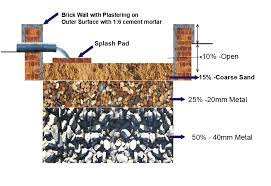Rainwater harvesting is a practice of collecting and storing rainwater for future use. In recent years, it has become increasingly popular as an alternative water source, especially in areas where water is scarce or groundwater is contaminated. Rainwater harvesting pits are one of the most common methods of collecting and storing rainwater.
They are designed to capture rainwater runoff from roofs and other surfaces and store it for future use. The pits are usually constructed using concrete, brick, or stone and can be built in a variety of sizes and shapes. The most common type of rainwater harvesting pit is an underground storage tank. This type of tank is usually buried several feet below the surface, and is designed to collect runoff from roofs and other surfaces. The runoff is then directed into the tank where it is stored for future use. Underground storage tanks can be made from a variety of materials, including plastic, fiberglass, and concrete.
Rainwater harvesting pits can also be constructed above ground. These pits are typically made of concrete or stone and are designed to capture runoff from roofs and other surfaces. They are usually constructed with a lid or cover to keep out debris and animals. The water stored in these pits is typically used for garden or lawn irrigation, or for other non-potable purposes. In addition to collecting and storing rainwater, rainwater harvesting pits can also be used to filter and purify the water. This is especially important if the runoff is coming from an area where pollutants, such as fertilizers and pesticides, are present.
Filtering and purifying the water can help reduce the risk of contamination and make it suitable for use in the home or garden. Rainwater harvesting pits can be a great way to conserve water and reduce water bills. They can also help protect the environment by reducing runoff and preserving the natural water supply. In addition, they can provide a reliable source of water in areas where water is scarce or groundwater is contaminated. Rainwater harvesting pits are relatively easy to construct and maintain. They require minimal maintenance, and can be built in a variety of sizes and shapes to fit any location. In addition, they can be relatively inexpensive to install, depending on the size and complexity of the system.
Rainwater harvesting pits are a great way to conserve water and reduce water bills. They can also help protect the environment by reducing runoff and preserving the natural water supply. In addition, they can provide a reliable source of water in areas where water is scarce or groundwater is contaminated.
Rainwater Harvesting Pit Construction In Kerala
Rainwater harvesting pits are simple in design and construction. They are typically constructed from concrete, bricks, or stone, and lined with a water-proof material such as plastic or rubber. The pit is usually built on a slope so that the collected rainwater flows from the higher end to the lower end, where it is stored. The rainwater can then be used for a variety of purposes such as watering gardens, flushing toilets, or providing drinking water.
The first step in constructing a rainwater harvesting pit is to determine the size and location of the pit. The size of the pit will depend on the amount of rainwater that needs to be collected, the amount of water that will be used, and the size of the area where the pit will be located. It is important to choose a location that is flat, has good drainage, and is close to the roof or other collection surface. The pit should also be a safe distance away from any structures such as buildings, trees, or power lines.
Once the location and size of the pit have been determined, the construction can begin. The first step is to dig a hole for the pit. The size of the hole will depend on the size of the pit and the material that will be used for the pit walls. The walls of the pit should be built with either brick, concrete, or stone and lined with a water-proof material such as plastic or rubber. The slope of the walls should be such that the collected rainwater flows from the higher end to the lower end of the pit. Once the pit has been dug and the walls have been constructed, the next step is to install a drain system.
This system will allow the collected rainwater to flow out of the pit and into a storage container or other drainage system. The drain system should be constructed so that it is able to withstand any possible flooding that may occur. After the drain system has been installed, the final step is to install a filtration system. This system will help to remove any debris or contamination that may be present in the collected rainwater. The filtration system should be installed according to the manufacturer’s instructions and should be maintained regularly.
After the rainwater harvesting pit has been constructed, it should be tested for any leakage or other issues. The pit should be monitored regularly to ensure that it is functioning properly. If any problems are found, they should be addressed immediately to ensure that the pit is operating efficiently and safely. Rainwater harvesting pits are an easy and efficient way to collect and store rainwater for future use. With proper construction and maintenance, a rainwater harvesting pit can provide a reliable source of water for a variety of purposes.

